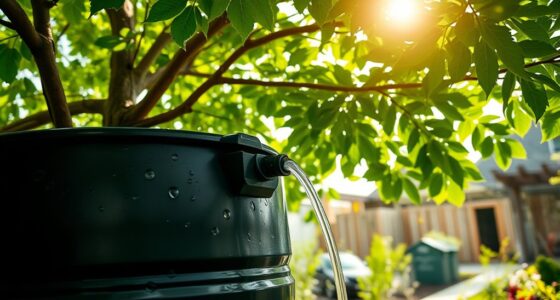To save money on utilities year-round, upgrade to energy-efficient appliances and LED lighting to cut energy use. Use smart thermostats and automated systems to optimize heating, cooling, and lighting, reducing waste. Regularly maintain appliances and adjust your household habits to avoid unnecessary consumption. Combining these strategies makes savings effortless and sustainable. Keep exploring ways to enhance your home’s efficiency, and you’ll discover even more tips for cutting costs all year long.
Key Takeaways
- Upgrade to energy-efficient appliances and LED lighting to reduce ongoing electricity and water bills.
- Use smart thermostats and automated lighting to optimize energy use based on occupancy and schedules.
- Regularly maintain appliances and HVAC systems for peak efficiency and longer lifespan.
- Incorporate energy-saving habits, such as unplugging devices and adjusting thermostats when away.
- Monitor energy consumption with smart devices to identify and eliminate unnecessary usage.

Are you looking for simple ways to cut your utility bills without sacrificing comfort? One effective method is investing in energy-efficient appliances. These appliances use less electricity, water, and energy overall, which translates into noticeable savings over time. For example, swapping out your old refrigerator or dishwasher for newer models with high Energy Star ratings can considerably reduce your monthly expenses. Not only do these appliances consume less power, but they also perform better and last longer, making them a smart long-term investment. Additionally, energy-efficient lighting options like LED bulbs use a fraction of the energy incandescent bulbs do, yet provide just as much brightness. Replacing your traditional bulbs with LEDs is an easy, low-cost step toward reducing your electricity bill. Implementing energy-saving strategies can further enhance your cost reductions and promote sustainable habits.
Another powerful way to save money year-round is by harnessing smart home technology. Smart thermostats, for instance, allow you to control your heating and cooling systems remotely. You can set schedules that align with your daily routine, ensuring you’re not wasting energy when you’re away or asleep. These devices learn your preferences over time, adjusting settings automatically to optimize comfort and efficiency. As a result, you’ll notice reduced heating and cooling costs without feeling a difference in comfort. Smart home technology also extends to lighting, with automated systems that turn off lights when a room is unoccupied, preventing waste. Some smart systems even monitor your energy consumption, providing detailed insights and tips to further cut costs.
Combining energy-efficient appliances with smart home technology maximizes your savings. For instance, syncing your smart thermostat with your smart lighting can create a harmonious system that minimizes energy use while maintaining comfort. These tools give you greater control over your energy habits, helping you identify patterns that lead to unnecessary expense. Plus, many smart devices can be programmed to work together seamlessly, making your home more efficient with minimal effort.
Frequently Asked Questions
How Can I Improve My Home’s Insulation Effectively?
To improve your home’s insulation effectively, start by sealing your windows to prevent drafts and heat loss. Next, upgrade your attic insulation to ensure better temperature regulation. Check for gaps around window frames and add weatherstripping where needed. Insulate your attic properly, using high-quality materials, to keep warm air inside during winter and cool air during summer. These steps can considerably boost your home’s energy efficiency and save you money.
Are Smart Thermostats Worth the Investment Long-Term?
Smart thermostats are worth the investment long-term because they boost your cost savings by optimizing your heating and cooling. They adapt to your schedule and preferences, reducing energy waste. Plus, you’ll want to check device compatibility to make certain of seamless integration with your existing system. Over time, the energy efficiency and convenience they offer can save you a significant amount on utility bills, making them a smart, worthwhile upgrade.
What Are the Best Energy-Efficient Appliances for My Budget?
If you’re looking for budget appliances that boost energy efficiency, consider brands like Whirlpool, LG, or Samsung, which offer reliable options at affordable prices. Look for ENERGY STAR-certified models, which use less energy and save you money over time. Focus on key appliances like refrigerators, dishwashers, and washing machines. Choosing efficient appliances now helps cut your utility bills while fitting your budget, making your home more eco-friendly.
How Can I Identify Leaks and Drafts in My Home?
You can identify leaks and drafts by checking window seals and caulking gaps around doors and windows. Feel for cold air or drafts by holding your hand near these areas, especially during different times of the day. Use a lit candle or incense stick to see if the smoke wavers, indicating leaks. Seal any gaps you find to improve energy efficiency and lower your utility bills year-round.
Are There Government Rebates for Upgrading to Energy-Efficient Systems?
Yes, you can benefit from government rebates and energy-efficient incentives when upgrading your home. Many programs offer financial incentives to encourage energy-efficient systems, like HVAC, solar panels, and insulation. Check with your local or federal agencies to find available rebates. These incentives can considerably reduce your upfront costs and help you save money long-term, making it easier to invest in eco-friendly upgrades that lower your utility bills.
Conclusion
By making small, consistent changes, you can substantially cut your utility bills year-round. Remember, heating and cooling account for nearly 50% of energy costs in most homes, so optimizing these systems saves you money and energy. Did you know that sealing leaks can reduce energy loss by up to 30%? Keep these tips in mind, and you’ll enjoy lower bills while helping the environment. Small efforts add up to big savings over time!








